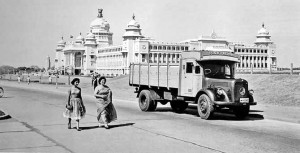Adil Jal Darukhanawala’s book, Mercedes-Benz Winning makes for an interesting read, both in terms of the brand’s sporting history and its journey in India.
Story by:
Team CV
The commercial vehicle history in India is highly fragmented. It is, in fact, far too fragmented to be put together in an interesting tale that would provide an image of how the hardy machines contributed towards the development of the country. A detailed narration of Mercedes-Benz commercial vehicle journey in India comes as a valuable trove of information therefore in Adil Jal Darukhanawala’s book, Mercedes-Benz Winning. The book, depicting the journey of the iconic German brand beginning 1885 when Carl Benz built the world’s first automobile, a three-wheeler, propelled by an internal combustion engine fuelled by Gasoline, begins by subtly narrating the rise of support trucks at sporting events. The narration presents an idea of how the support trucks contributed to the success of Mercedes-Benz sports cars. A clearer mention of the support trucks begins with a chapter in the book, ‘Form follows Function – Scientific art of a transporter’. Beginning with an explanation that the transporters were born out of the need for fast cars to have a supremely fast back up and support, Adil has mentioned in a highly interesting way the need for a series of race car transporters felt by the then Mercedes-Benz race team administrator Alfred Neubauer. The book mentions that the first in the long line of fast car transporters was the 24/100/140 supercharged tourer based on the very first design by Dr. Ferdinand Porsche for Daimler Motoren Gesellschaft in 1924. Also mentioned is the building of a race car transporter in 1954 besides a winning Grand Prix machine that looked like it could race itself! By 1930s, and in-line with the rise in car sporting activities, lorries like the Mercedes-Benz Lo 2750 came to be a reliable transporter of race cars across Europe. Each truck could carry one W125 or a W154/163.
The Indian connection of Mercedes-Benz and its winning ways begins with a description of how the maharajas of various states, connoisseurs of good food, art and automobiles among others worldly thinks, took to them. Described in the book is the arrival of the first Benz Viktoria in Delhi in 1887 as per the Benz & Cie records. The book goes on to highlight the Indian leg of the star’s journey with the picture of a truck from the 1930s (a Lo 2000 model) being serviced in 1952. This particular truck was employed by a transport firm in Dewas, Madhya Pradesh, and logged over 1.5 million km! Adil has aptly stated that the commercial vehicle bit of Mercedes-Benz started on a smaller scale in India; with an initial order of two units of Lo 2000 in 1933. Describing the growth of trucks in an interesting way, Adil has also explained how these trucks found employment in the harbour areas of Bombay (now Mumbai), Goa and Madras (now Chennai). The proliferation of Mercedes-Benz commercial vehicles has been supported by numbers. Mentioning that most earlier era Mercedes-Benz trucks were performing when Telco and Daimler-Benz inked an agreement to produce commercial vehicles in India, Adil has tastefully narrated the turn of events. He has also narrated the reluctance to diesel powered trucks, and how this adversely affected the country during the war. Apart from stating important and interesting developments, including the first air-conditioned coach on the Mercedes-Benz 1210 bus chassis built by VST Motors, Madras, Adil has chronicled the Mercedes-Benz Indian connection in good detail. He has narrated the German major’s connection with the Firodias of Pune. He has mentioned about the developments that led to the Matador and the Tempo Traveller; the powering of the two by the Mercedes-Benz OM616 diesel engine.
Apart from the entry of Mercedes-Benz Actros in India in 2007, and the introduction of the luxury inter-city bus based on O 500 bus chassis, the book has a chapter dedicated to the establishment of Daimler India Commercial Vehicles at Chennai. To win the hearts of Indian commercial vehicle buyers, the German major unveiled a new brand, BharatBenz, in India. BharatBenz trucks began rolling out of the Chennai Greenfield plant of Daimler, built with an investment of Euro 360 million, in 2012. Under the Fuso brand, the trucks made at Chennai are being exported to African and Asian markets. The company is also making buses at Chennai. A must read, the book, looking at the picture on the jacket, may be interpreted as a narration of the sporting history of Mercedes-Benz, it is however much more than that. The book adds a new dimension to the word meaning by narrating the winning ways of Mercedes-Benz as a commercial vehicle manufacturer as well. It does so in an interesting manner. And, right from the time
when Adil mentions his rendezvous with two souls from a local newspaper on August 26, 1977.
————————————–
Adil Jal Darukhanawala is the founder editor of CV.




























